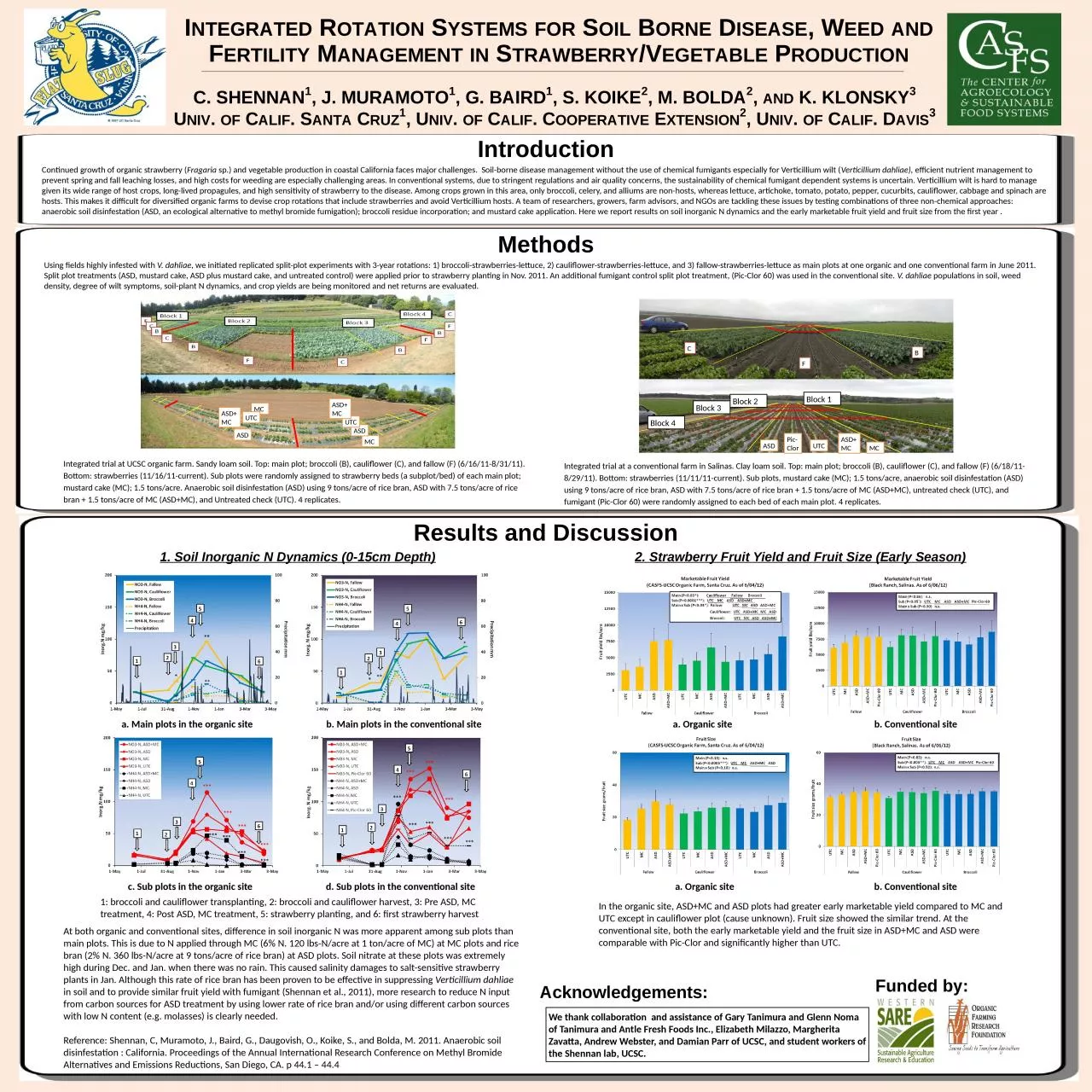

Fragaria sp and vegetable production in coastal California faces major challenges Soilborne disease management without the use of chemical fumigants especially for Verticillium wilt Verticillium dahliae ID: 1002434
Download Presentation The PPT/PDF document "Continued growth of organic strawberry (" is the property of its rightful owner. Permission is granted to download and print the materials on this web site for personal, non-commercial use only, and to display it on your personal computer provided you do not modify the materials and that you retain all copyright notices contained in the materials. By downloading content from our website, you accept the terms of this agreement.
1. Continued growth of organic strawberry (Fragaria sp.) and vegetable production in coastal California faces major challenges. Soil-borne disease management without the use of chemical fumigants especially for Verticillium wilt (Verticillium dahliae), efficient nutrient management to prevent spring and fall leaching losses, and high costs for weeding are especially challenging areas. In conventional systems, due to stringent regulations and air quality concerns, the sustainability of chemical fumigant dependent systems is uncertain. Verticillium wilt is hard to manage given its wide range of host crops, long-lived propagules, and high sensitivity of strawberry to the disease. Among crops grown in this area, only broccoli, celery, and alliums are non-hosts, whereas lettuce, artichoke, tomato, potato, pepper, cucurbits, cauliflower, cabbage and spinach are hosts. This makes it difficult for diversified organic farms to devise crop rotations that include strawberries and avoid Verticillium hosts. A team of researchers, growers, farm advisors, and NGOs are tackling these issues by testing combinations of three non-chemical approaches: anaerobic soil disinfestation (ASD, an ecological alternative to methyl bromide fumigation); broccoli residue incorporation; and mustard cake application. Here we report results on soil inorganic N dynamics and the early marketable fruit yield and fruit size from the first year .Introduction1. Soil Inorganic N Dynamics (0-15cm Depth)2. Strawberry Fruit Yield and Fruit Size (Early Season)Integrated trial at UCSC organic farm. Sandy loam soil. Top: main plot; broccoli (B), cauliflower (C), and fallow (F) (6/16/11-8/31/11). Bottom: strawberries (11/16/11-current). Sub plots were randomly assigned to strawberry beds (a subplot/bed) of each main plot; mustard cake (MC); 1.5 tons/acre. Anaerobic soil disinfestation (ASD) using 9 tons/acre of rice bran, ASD with 7.5 tons/acre of rice bran + 1.5 tons/acre of MC (ASD+MC), and Untreated check (UTC). 4 replicates.Using fields highly infested with V. dahliae, we initiated replicated split-plot experiments with 3-year rotations: 1) broccoli-strawberries-lettuce, 2) cauliflower-strawberries-lettuce, and 3) fallow-strawberries-lettuce as main plots at one organic and one conventional farm in June 2011. Split plot treatments (ASD, mustard cake, ASD plus mustard cake, and untreated control) were applied prior to strawberry planting in Nov. 2011. An additional fumigant control split plot treatment, (Pic-Clor 60) was used in the conventional site. V. dahliae populations in soil, weed density, degree of wilt symptoms, soil-plant N dynamics, and crop yields are being monitored and net returns are evaluated. MethodsIntegrated trial at a conventional farm in Salinas. Clay loam soil. Top: main plot; broccoli (B), cauliflower (C), and fallow (F) (6/18/11-8/29/11). Bottom: strawberries (11/11/11-current). Sub plots, mustard cake (MC); 1.5 tons/acre, anaerobic soil disinfestation (ASD) using 9 tons/acre of rice bran, ASD with 7.5 tons/acre of rice bran + 1.5 tons/acre of MC (ASD+MC), untreated check (UTC), and fumigant (Pic-Clor 60) were randomly assigned to each bed of each main plot. 4 replicates.CFBASDPic-ClorMCASD+MCUTCBlock 1Block 2Block 3Block 4Results and Discussion a. Main plots in the organic site b. Main plots in the conventional site c. Sub plots in the organic site d. Sub plots in the conventional site At both organic and conventional sites, difference in soil inorganic N was more apparent among sub plots than main plots. This is due to N applied through MC (6% N. 120 lbs-N/acre at 1 ton/acre of MC) at MC plots and rice bran (2% N. 360 lbs-N/acre at 9 tons/acre of rice bran) at ASD plots. Soil nitrate at these plots was extremely high during Dec. and Jan. when there was no rain. This caused salinity damages to salt-sensitive strawberry plants in Jan. Although this rate of rice bran has been proven to be effective in suppressing Verticillium dahliae in soil and to provide similar fruit yield with fumigant (Shennan et al., 2011), more research to reduce N input from carbon sources for ASD treatment by using lower rate of rice bran and/or using different carbon sources with low N content (e.g. molasses) is clearly needed.Reference: Shennan, C, Muramoto, J., Baird, G., Daugovish, O., Koike, S., and Bolda, M. 2011. Anaerobic soil disinfestation : California. Proceedings of the Annual International Research Conference on Methyl Bromide Alternatives and Emissions Reductions, San Diego, CA. p 44.1 – 44.4In the organic site, ASD+MC and ASD plots had greater early marketable yield compared to MC and UTC except in cauliflower plot (cause unknown). Fruit size showed the similar trend. At the conventional site, both the early marketable yield and the fruit size in ASD+MC and ASD were comparable with Pic-Clor and significantly higher than UTC. a. Organic site b. Conventional site 1: broccoli and cauliflower transplanting, 2: broccoli and cauliflower harvest, 3: Pre ASD, MC treatment, 4: Post ASD, MC treatment, 5: strawberry planting, and 6: first strawberry harvest a. Organic site b. Conventional site Funded by:We thank collaboration and assistance of Gary Tanimura and Glenn Noma of Tanimura and Antle Fresh Foods Inc., Elizabeth Milazzo, Margherita Zavatta, Andrew Webster, and Damian Parr of UCSC, and student workers of the Shennan lab, UCSC.Acknowledgements:MCASDUTCASD+MCMCUTCASD+MCASD